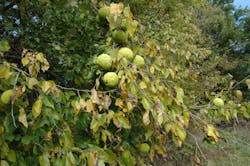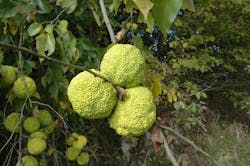Incompatible trees can pose a variety of risks throughout energy rights-of-way (ROW). For one, expansive root systems not only threaten the integrity of oil and gas pipeline infrastructure, but they also impede accessibility for essential maintenance. Many trees also pose a risk of interfering with towers and overhead powerlines, especially when they’re poorly maintained or impacted by storms and strong winds — Osage orange (Maclura pomifera) is no exception.
Native to the south-central United States, this wind-pollinated species thrives in nearly all climates and temperatures. This is a problem for vegetation managers, as Osage orange trees feature expansive lateral-spreading root systems that can apply pressure to pipeline joints and coatings. To make matters worse, these deciduous trees can grow up to 65 feet tall, posing a significant threat to grow or fall into powerlines and other electrical transmission equipment. It isn’t hard to identify Osage orange, but knowing how to control it effectively can be a little more challenging for energy companies and their vegetation management partners.
Why Osage Orange Control Is Important
In addition to impeding accessibility to pipeline or electrical transmission infrastructure, Osage orange has become an invasive species in poorly managed areas. Failing to control this thorny tree effectively can lead to the displacement of desirable vegetation that supports the reliability of utility service as well as native wildlife that relies on ROW resources to survive.
What Does Osage Orange Look Like?
The height of Osage orange trees can be similar to other trees or tall shrubs. However, the tree’s deeply furrowed bark and thorny branches are just one of a few distinguishing features that set it apart from others:
Leaves
The deciduous oval-shaped leaves of Osage orange trees develop in alternating clusters at the end of short spurs. These leaf blades can measure up to 5 inches long and 2.5 inches wide. They are normally dark-green, smooth and waxy on the surface. On their underside, they are hairy and pale green.
Flowers, Fruit and Seeds
Male and female Osage orange trees feature different types of flowers. The green and hairy male flowers appear from mid-May to June and develop in cylindrical clusters with four stamens and large yellow anthers. Comparatively, female flowers bloom in dense spherical clusters from April through June. Female flowers fuse together in late summer and early fall to form fruit that can measure up to 5 inches in diameter. Individual cream-colored and oval-shaped seeds, which thrive in well-drained soils, can be found embedded inside each female flower.
How to Control Osage Orange Effectively
Mechanized mowing and other mechanical vegetation control strategies can temporarily reduce the height of incompatible trees. However, these practices spread seeds and fail to affect underground root systems. As a result, tree regrowth commonly leads to an increase in maintenance requirements and associated costs when a mechanized approach is the sole strategy for incompatible tree control.
Instead of relying exclusively on this expensive and time-consuming approach to control Osage orange trees, consider the benefits of selective herbicide applications:
· Efficient and cost-effective
· Long-lasting results that reduce long-term maintenance costs
· Minimal damage to desirable off-target vegetation
Using selective herbicide applications as part of an Integrated Vegetation Management strategy can support the development of low-growing plant communities that would otherwise be damaged by mechanical control solutions. In turn, these desirable plants create a natural barrier against the reestablishment of trees and other incompatible plant species. In fact, the last three years of ROW environmental research data shared by researchers with Pennsylvania State University show that low-volume and high-volume foliar herbicide applications generally lead to lower incompatible stem densities in utility ROW than plots managed with mowing or hand-cutting practices.
One of the most noteworthy IVM solutions on the market is TerraVue® herbicide from Corteva Agriscience. TerraVue controls Osage orange as well as more than 140 other broadleaf weeds and brush species. For optimum results on Osage orange, apply TerraVue to the leaves of targeted trees at a rate of 2 to 2.85 ounces per acre with 16 to 32 fluid ounces per acre of Garlon® 4 Ultra herbicide after full leaf out.
How Do Foliar Herbicide Treatments Work?
Foliar treatments allow the leaves of targeted vegetation to absorb and translocate herbicide chemistries to other parts of the plant, often resulting in holistic control and long-lasting results. This strategy is particularly effective for pipeline vegetation managers as it prevents the tree’s root system from taking up nutrients and supporting future regrowth.
If you are responsible for managing vegetation throughout electric utility ROW and rely on mechanical control methods for tree-trimming applications, chemical side-trimming is an alternative approach that allows you to only control the limbs of trees that pose a threat to overhead powerlines and other above-ground infrastructure. While mechanical control methods only lead to regrowth, chemical side-trimming inhibits the regeneration of problematic limbs.
For more information on effective vegetation control strategies that successfully control incompatible plant species throughout energy ROW or other sites maintained by vegetation managers, visit our Invasive Watch archive.
™ ® Trademarks of Corteva Agriscience and its affiliated companies. Under normal field conditions, TerraVue® is nonvolatile. TerraVue has no grazing or haying restrictions for any class of livestock, including lactating dairy cows, horses (including lactating mares) and meat animals prior to slaughter. Label precautions apply to forage treated with TerraVue and to manure and urine from animals that have consumed treated forage. TerraVue is not registered for sale or use in all states. Contact your state pesticide regulatory agency to determine if a product is registered for sale or use in your state. Consult the label for full details. State restrictions on the sale and use of Garlon® 4 Ultra apply. Consult the label before purchase or use for full details. Always read and follow label directions. © 2022 Corteva.
Sponsored By:



